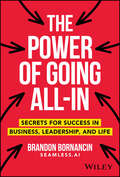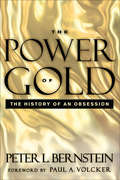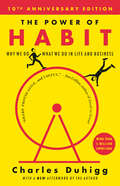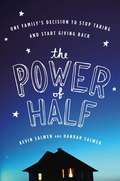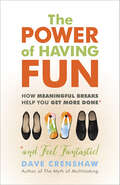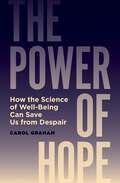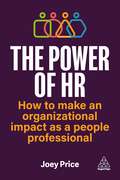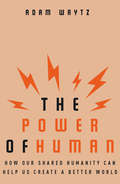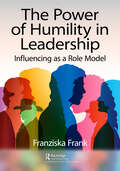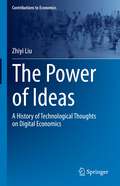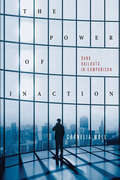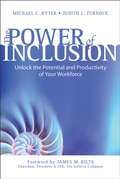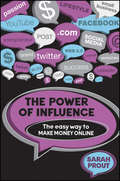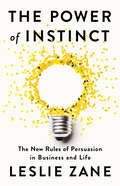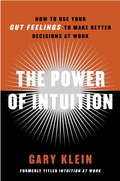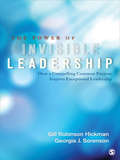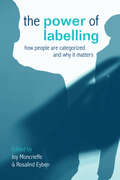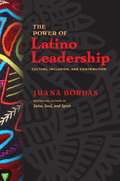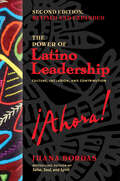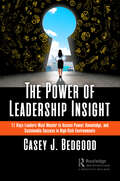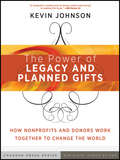- Table View
- List View
The Power of Going All-In: Secrets for Success in Business, Leadership, and Life
by Brandon BornancinDiscover a proven framework for leadership you can apply to your own unique environment In The Power of Going All In, serial entrepreneur and sales leader Brandon Bornancin delivers a first-person account of what it takes to build, lead, and manage a world-class company. The author draws on his many years of experience launching and managing successful companies to present effective strategies for inspiring your people to do more, be more, and achieve more. You’ll discover a customizable framework you can apply to your own environment to create your own unique path to leadership greatness, at school, at work, and anywhere else you’re responsible for the performance of those who follow you. You’ll find: Tried-and-tested methods for unlocking the potential of the people you lead Effective alternatives to counter-productive leadership “strategies,” like micromanagement Reasons why leadership isn’t about the letters behind your name or fancy titles on your office door A practical and effective toolkit for entrepreneurs, managers, executives, board members, founders, sales professionals, and other leaders looking for ways to harness the full potential of the people they lead, The Power of Going All In is also perfect for those looking for a leadership methodology that’s been proven to work in the real world.
The Power of Gold: The History of an Obsession
by Peter L. Bernstein"The need for realism in reform of its monetary system is what makes Bernstein’s story of the Power of Gold so timely. It is a compelling reminder that maintaining a fixed price for gold and fixed exchange rates were difficult even in a simpler financial environment….Peter Bernstein was reluctant to project the story of gold into the future. But to me his message was clear. Yes, gold will be with us, valued not only for its intrinsic qualities but as a last refuge and store of value in turbulent times. But its days as money, as a means of payment and a fixed unit of account are gone." —From the New Foreword by Paul Volcker This bestselling book reveals a record of human nature in the ubiquity of gold with a new foreword by Paul Volcker In this exciting book, the late Peter L. Bernstein tells the story of history's most coveted, celebrated, and inglorious asset: gold. From the ancient fascinations of Moses and Midas through the modern convulsions caused by the gold standard and its aftermath, gold has led many of its most eager and proud possessors to a bad end. And while the same cycle of obsession and desperation may reverberate in today's fast-moving, electronically-driven markets, the role of gold in shaping human history is the striking feature of this tumultuous tale. Such is the power of gold. Whether it is Egyptian pharaohs with depraved tastes, the luxury-mad survivors of the Black Death, the Chinese inventor of paper money, the pirates on the Spanish Main, or the hardnosed believers in the international gold standard, gold has been the supreme possession. It has been an icon for greed and an emblem of rectitude, as well as a vehicle for vanity and a badge of power that has shaped the destiny of humanity through the ages. Discusses the beginnings of gold as something with magical, religious, and artistic qualities and follows its trail as we progress to the invention of coinage, the transformation of gold into money, and the gold standard Other bestselling books by the late Peter Bernstein: Against the Gods, Capital Ideas, and Capital Ideas Evolving Contemplates gold from the diverse perspectives of monarchs and moneyers, potentates and politicians, men of legendary wealth and others of more plebeian beginnings Far more than a tale of romantic myths, daring explorations, and the history of money and power struggles, The Power of Gold suggests that the true significance of this infamous element may lie in the timeless passions it continues to evoke, and what this reveals about ourselves.
The Power of Habit: Why We Do What We Do in Life and Business (Playaway Adult Nonfiction Ser.)
by Charles DuhiggA young woman walks into a laboratory. Over the past two years, she has transformed almost every aspect of her life. She has quit smoking, run a marathon, and been promoted at work. The patterns inside her brain, neurologists discover, have fundamentally changed. Marketers at Procter & Gamble study videos of people making their beds. They are desperately trying to figure out how to sell a new product called Febreze, on track to be one of the biggest flops in company history. Suddenly, one of them detects a nearly imperceptible pattern--and with a slight shift in advertising, Febreze goes on to earn a billion dollars a year. An untested CEO takes over one of the largest companies in America. His first order of business is attacking a single pattern among his employees--how they approach worker safety--and soon the firm, Alcoa, becomes the top performer in the Dow Jones. What do all these people have in common? They achieved success by focusing on the patterns that shape every aspect of our lives. They succeeded by transforming habits. In The Power of Habit, award-winning New York Times business reporter Charles Duhigg takes us to the thrilling edge of scientific discoveries that explain why habits exist and how they can be changed. With penetrating intelligence and an ability to distill vast amounts of information into engrossing narratives, Duhigg brings to life a whole new understanding of human nature and its potential for transformation. Along the way we learn why some people and companies struggle to change, despite years of trying, while others seem to remake themselves overnight. We visit laboratories where neuroscientists explore how habits work and where, exactly, they reside in our brains. We discover how the right habits were crucial to the success of Olympic swimmer Michael Phelps, Starbucks CEO Howard Schultz, and civil-rights hero Martin Luther King, Jr. We go inside Procter & Gamble, Target superstores, Rick Warren's Saddleback Church, NFL locker rooms, and the nation's largest hospitals and see how implementing so-called keystone habits can earn billions and mean the difference between failure and success, life and death. At its core, The Power of Habit contains an exhilarating argument: The key to exercising regularly, losing weight, raising exceptional children, becoming more productive, building revolutionary companies and social movements, and achieving success is understanding how habits work. Habits aren't destiny. As Charles Duhigg shows, by harnessing this new science, we can transform our businesses, our communities, and our lives.From the Hardcover edition.
The Power of Half: One Family's Decision to Stop Taking and Start Giving Back
by Kevin Salwen Hannah SalwenIt all started when 15-year old Hannah Salwen, idealistic, but troubled by a growing sense of injustice in the world, had a eureka moment when a homeless man in her neighborhood was juxtaposed against a glistening Mercedes coupe "You know, Dad," she said, pointing, "If that man had a less nice car, that man could have a meal." This glaring disparity let the Salwen family of four, caught up like so many other Americans in this age of consumption and waste, to follow Hannah's urge to stop talking and start doing. And so they embarked on an incredible journey together, deciding to sell their Atlanta mansion, downsize to a house half its size, and give half of their profits to a worthy charity Each week they met over dinner to discuss their plan. At first it was an outlandish scheme. "What, are you crazy? No way!" Then it was a challenge. "We are TOTALLY doing this." It would transport them across the globe and well out of their comfort zone. In the end they found a needy village in Ghana where their commitment of funds and their unwavering follow through would change the lives of hundreds, for good. It would also alter irrevocably the lives of four normal Americans who learned together that half could be so much more. With deft prose, an unassuming tone, and an endearing sense of humor, The Power of Half chronicles this remarkable, unlikely journey, this reimagining of the American dream, one family at a time. It also offers readers a very accessible road map to employ the power of half to their own lives, no matter one's means or resources. In that way, it shows readers, how to connect their families through a unifying purpose, an antidote to the splintering of American families in this era of iPods, video-gaming, and other solo activities.
The Power of Having Fun: How Meaningful Breaks Help You Get More Done *and Feel Fantastic!
by Dave Crenshaw&“A powerful system for making fun a vital part of your business strategy&” from the author of The Myth of Multitasking (Asher Raphael, Co-CEO and partner, Power Home Remodeling). Fun is the key to success! If you want to be successful, having fun is not an option. It&’s a necessity. By making fun a top priority—taking meaningful, enjoyable breaks each day, week, month, and year—you&’ll not only be happier but be more productive, too! Using scientific evidence, real-world case studies, and a healthy dose of wit, bestselling author Dave Crenshaw shows that a regular respite is like a little oasis in your workday. It refreshes and reinvigorates, recharges your batteries—helping you accomplish more with less effort! The Power of Having Fun coaches you through the five-step system thousands of leaders have utilized to boost productivity and propel their careers—all while feeling fantastic! Let Dave Crenshaw lower your stress, raise your results, and restore recess to your routine. &“The simple wisdom in Dave&’s book might just change your life.&” —Seth Godin, New York Times-bestselling author of This Is Marketing &“Let&’s face it, the nine-to-five workday is a thing of the past. Dave really gets that the companies that will ultimately succeed are those that embrace the flexible workday and empower their employees.&” —Brian Halligan, cofounder and CEO, HubSpot &“The principles Dave teaches in this book have helped me be not only a more productive leader but a more grounded human being. Dave&’s influence in my life and career has been invaluable.&” —Catherine Hoke, founder and CEO, Defy Ventures
The Power of Hope: How the Science of Well-Being Can Save Us from Despair
by Carol GrahamWhy hope matters as a metric of economic and social well-beingIn a society marked by extreme inequality of income and opportunity, why should economists care about how people feel? The truth is that feelings of well-being are critical metrics that predict future life outcomes. In this timely and innovative account, economist Carol Graham argues for the importance of hope—little studied in economics at present—as an independent dimension of well-being. Given America’s current mental health crisis, thrown into stark relief by COVID, hope may be the most important measure of well-being, and researchers are tracking trends in hope as a key factor in understanding the rising numbers of “deaths of despair” and premature mortality.Graham, an authority on the study of well-being, points to empirical evidence demonstrating that hope can improve people’s life outcomes and that despair can destroy them. These findings, she argues, merit deeper exploration. Graham discusses the potential of novel well-being metrics as tracking indicators of despair, reports on new surveys of hope among low-income adolescents, and considers the implications of the results for the futures of these young adults.Graham asks how and why the wealthiest country in the world has such despair. What are we missing? She argues that public policy problems—from joblessness and labor force dropout to the lack of affordable health care and inadequate public education—can’t be solved without hope. Drawing on research in well-being and other disciplines, Graham describes strategies for restoring hope in populations where it has been lost. The need to address despair, and to restore hope, is critical to America’s future.
The Power of HR: How to Make an Organizational Impact as a People Professional
by Joey PriceHow can I influence the business and drive meaningful change as an HR professional? How can I improve organizational performance and showcase my value? How can I prove that HR professionals are key to company success? The Power of HR is a practical guide that answers all these questions and equips HR professionals with everything they need to make an impact on the organization. It outlines the key aspects of the HR role, examines how they add value to the business and explains how practitioners can demonstrate this value to the organization. It includes coverage of the importance of attracting and hiring the people with the skills the business needs to meet its objectives, effective onboarding of these staff as well as guidance on how to communicate the value of this to the business. This practical book also covers HR's essential role in company culture and why people professionals are integral to fostering diversity, equity, inclusion and belonging at work and the corresponding effect this has on company performance. This book also has a dedicated chapter on using insights from data and analytics in HR activity to provide people professionals with the evidence they need to make an impact and influence business priorities. Full of real-world examples from companies such as Adobe, Google, LexisNexis, Jumpstart HR and NPR as well as interviews from HR professionals and industry experts including Dave Ulrich, Lars Schmidt and Adonica Black, this is ideal reading for all HR professionals wanting to demonstrate their value to the organization, drive change and influence business decision making.
The Power of Human: How Our Shared Humanity Can Help Us Create A Better World
by Adam WaytzAn urgent yet hopeful analysis of the surge in dehumanization, and how we can reverse it. The unprecedented access to other humans that technology provides has ironically freed us from engaging with them. Thanks to social media, we can know a campaigning politician’s platform; an avid traveler’s restaurant recommendations; and the daily emotional fluctuations of our friends without ever even picking up the phone. According to social psychologist Adam Waytz, our increasingly human-free lives come with a serious cost that we’ve already begun to pay: the loss of our humanity. Humans have superpowers. More than any other psychological stimulus, our presence can make experiences feel significant, inspire moral behavior, and encourage action. Recent studies suggest that we even have power over mortality—the survival rate of individuals with stronger social relationships has been found to be twice as high as those with weak relationships. The Power of Human shows us how to rehumanize and harness these unique abilities to improve our lives, beginning with our jobs. The remedy for the dehumanized worker is twofold. Employers, Waytz argues, must instill humanity into work by capitalizing on distinctly human skills, especially sociability and variability. Meanwhile, workers need to put to rest the idea that you are what you do and instead detach their personal identities from their occupations. Waytz offers a similarly science-based method to counter the rising threat that technology poses to our humanity, outlining how we can design human-machine partnerships that optimize the strengths of both parties. Finally, he reveals how, by humanizing intimacy and conflict in unexpected ways, we can strengthen relationships with both our friends and enemies. Essential reading for individuals and institutions alike, The Power of Human explains how we can solve one of our time’s biggest problems by better utilizing the influence we have on one another.
The Power of Humility in Leadership: Influencing as a Role Model
by Franziska FrankTo many people, the words ‘leader’ and ‘humble’ are not natural bedfellows. Yet once they have grasped the definition most employees desire a humble leader, while a majority of managers believe they already are one. What appears deceptively simple is trickier than expected. Narcissism, lack of perception, fixed mindsets, and neuronal default settings are only a few of the stumbling blocks on the path to humility. What exactly is this sought-after humility? Humility consists of four key elements: 1) Seeing one’s own strength and weaknesses and revealing them where needed for the bigger picture; 2) Appreciating others for what they are, do now and can do; 3) Being open and willing to learn; 4) Understanding that we are all only a small part of a larger picture, easily replaceable and favored by luck and circumstance. Therefore, humility has nothing to do with being weak or hiding the light under the bushel. Instead, it is about clarity, taking a step back from one’s ego and thus being able to serve the greater picture. The author’s own research with more than 2,000 managers contributes to the canon of positive effects of humility that have been measured by dozens of researchers during the last decade. Humility benefits employees (ranging from better performance, more innovation, stronger resilience to better client relations, and stronger morals), the organization (ranging from better ambidextrous strategies, a better culture to fewer sunk costs) and the managers themselves (ranging from more seen leadership potential to less stress and better relationships with employees). Dozens of case studies, quotes from more than 150 interviews with top managers, lively storytelling of real-life examples, and solid research with actionable take-aways, plus personal assessments, make this an eminently readable and practical book for managers worldwide.
The Power of Ideas: A History of Technological Thoughts on Digital Economics (Contributions to Economics)
by Zhiyi LiuAs the first academic monograph that a Chinese scholar discusses the histories of thoughts and ideas related to the development of digital economics, this book aims to make research from the perspective of the history of ideas and discuss the ideas influencing the development of digital economics and the evolution of related theories and thoughts with the methodology of interdisciplinary research.The human society is in the stage of major historic transition and enters the digital world with the main goal of developing the artificial world. In this world, the development of digital economics is significantly characterized by the deep interaction between the real and the virtual worlds, while the key triggering this paradigm reform is the evolution of ideas since the modern times. While involving the field of computer, these thoughts are also related to the fields of philosophy, ethics, communication and economics. Therefore, the results of the research on the history of ideas related to digital economics are required to really understand the depth of this discipline. If computationalism is the most important paradigm evolution of natural science, the most important paradigm evolution of social science is interdisciplinary complex science. In the meantime, this book is the most significant in understanding the nature of paradigm evolution related to the development of digital economics from the perspective of complex science and interdisciplinary systematic researches.Digital economics is in the foundation-laying phase, while this book mainly aims to historically narrate the thoughts of this discipline and hopes that readers can understand the influence of ideas in the old era on shaping the disciplines in the new era while exploring this new discipline. The construction of digital economics is a process of evolution. This book will be helpful to understand the underlying logic of the ideas constructed by the thinkers in different fields.
The Power of Ideas to Transform Healthcare: Engaging Staff by Building Daily Lean Management Systems
by Steve Hoeft Robert W. Pryor MDMany companies conduct Lean training and projects, but few have tapped the wealth of ideas in the minds of their staff like Baylor Scott and White Health. This book documents the path Steve Hoeft and Robert Pryor created at Baylor Scott and White Health and shares what worked as well as what didn t illustrating over seven years of successes and fai
The Power of Impact Investing: Putting Markets to Work for Profit and Global Good
by Judith Rodin Margot BrandenburgA new wave of investors is using impact investing to address some of the greatest challenges of our time-from climate change and water scarcity to lack of access to health care, education, and affordable housing-with the intention of also generating a financial return. <P><P>This couldn't happen at a more critical time. While philanthropy continues to be a transformative force for good, global philanthropic funds, even when combined with the development or aid budgets of many national governments, add up to mere billions of dollars. Meanwhile, the cost of solving the world's problems runs into the trillions.In The Power of Impact Investing, Rockefeller Foundation president Judith Rodin and Margot Brandenburg, two of the foremost experts in the field, explain what impact investing is, how it compares to philanthropy and traditional investments, where opportunities are evolving around the world, and how to get started.By sharing moving stories of impact investors and the exciting social enterprises benefiting from these investments, Rodin and Brandenburg offer a compelling resource for anyone interested in better understanding the power of impact investing-including retail investors, high-net-worth individuals, and heads of family offices, foundations, banks, and pension funds-while also offering experienced impact investors an opportunity to deepen their knowledge and benefit from the perspectives of other investors.
The Power of Inaction: Bank Bailouts in Comparison
by Cornelia WollBank bailouts in the aftermath of the collapse of Lehman Brothers and the onset of the Great Recession brought into sharp relief the power that the global financial sector holds over national politics, and provoked widespread public outrage. In The Power of Inaction, Cornelia Woll details the varying relationships between financial institutions and national governments by comparing national bank rescue schemes in the United States and Europe. Woll starts with a broad overview of bank bailouts in more than twenty countries. Using extensive interviews conducted with bankers, lawmakers, and other key players, she then examines three pairs of countries where similar outcomes might be expected: the United States and United Kingdom, France and Germany, Ireland and Denmark. She finds, however, substantial variation within these pairs. In some cases the financial sector is intimately involved in the design of bailout packages; elsewhere it chooses to remain at arm’s length.Such differences are often ascribed to one of two conditions: either the state is strong and can impose terms, or the state is weak and corrupted by industry lobbying. Woll presents a third option, where the inaction of the financial sector critically shapes the design of bailout packages in favor of the industry. She demonstrates that financial institutions were most powerful in those settings where they could avoid a joint response and force national policymakers to deal with banks on a piecemeal basis. The power to remain collectively inactive, she argues, has had important consequences for bailout arrangements and ultimately affected how the public and private sectors have shared the cost burden of these massive policy decisions.
The Power of Inclusion: Unlock the Potential and Productivity of Your Workforce
by Michael C. Hyter Judith L. TurnockThere is an enormous amount of wasted potential within organizations today because most do not adequately tap in to the wealth of human capital available to them. Most organizations believe that they are meritocracies, but that is a myth that masks the real situation of unequal opportunity that exists in most firms. Exclusionary tendencies are built into leadership, management, and human resources practices that perpetuate unequal opportunity. Most companies “sort and select,” hiring others most like themselves, and focus training and development on those who are identified as high potential. This book makes a business case for a new inclusive model of human resource development, driven by the demands of increasingly diverse workplaces and continuing expansion of the global economy. It demonstrates that people who succeed often acquire their talent because of the development attention they have received, and it shows how to create a culture of inclusion and development to unlock employee potential and productivity. The authors ’ approach — developing talent in all employees and aligning human resource systems and senior leadership commitment with that goal — is a response to a business challenge facing corporate North America today. The patterns of exclusion and preference that limit human potential are universal; this book offers management insights for any corporate audience serious about maximizing productivity in the competitive global economy.
The Power of Influence
by Sarah ProutThe internet offers a wondrous world of possibilities for anyone with an entrepreneurial streak, including the chance to gain international recognition and influence without even leaving the house! Social media platforms such as Twitter and Facebook make it possible to leverage the most powerful marketing tool available--you!--no technical wizardry or design savvy required.In this candid and accessible book, internet entrepreneur Sarah Prout reveals how anyone, with any level of experience, can build a successful online business and harness the power of influence with social media. She shares her tried-and-tested methods for networking and attracting subscribers and followers, debunks social media myths, road-tests a range of different business models, and gives you all the inspiration and power tips you'll need to get your online business--and bank account--thriving in no time.
The Power of Instinct: The New Rules of Persuasion in Business and Life
by Leslie ZaneAward-winning Fortune 500 brand consultant and behavioral expert Leslie Zane shatters conventional marketing wisdom, showing readers how to tap into the hidden brain where instinct prevails, creating a powerful network of connections that drive people to buy your product, company, or vision. People don&’t make decisions with their conscious mind, but on instinct. In The Power of Instinct, marketing consultant and behavioral science expert Leslie Zane shows that to grow a brand, business, or even a social movement, traditional persuasion tactics fall short. Instead, you must connect to the instinctive mind. And to do this, you need to understand the science of consumer choice and employ techniques that work with a person&’s brain, not against it. Zane uncovers the hidden network of connections that dictates the snap decisions we make and cracks the code on how to influence it. With a revolutionary set of rules for expanding the network, Zane shows us how to make any brand, business, political candidate, or idea the dominant instinctive choice. With science as your guide, as well as stories from the world&’s most successful brands from McDonald's and Lululemon to the Yankees and Taylor Swift, you'll learn: What kind of messages create the greatest amount of positive associations; Why finding new customers accelerates growth and relying on existing ones is a trap; Why emotional stories are not enough to drive trial and long-term brand loyalty. Whether you're an entrepreneur, Fortune 500 executive, marketing professional, or job seeker, mastering the power of instinct will help supercharge your growth and make whatever you&’re selling the first choice for any audience.
The Power of Intuition
by Gary KleinAt times in our careers, we've all been aware of a "gut feeling" guiding our decisions. Too often, we dismiss these feelings as "hunches" and therefore untrustworthy. But renowned researcher Gary Klein reveals that, in fact, 90 percent of the critical decisions we make is based on our intuition. In his new book, THE POWER OF INTUITION, Klein shows that intuition, far from being an innate "sixth sense," is a learnable--and essential--skill.Based on interviews with senior executives who make important judgments swiftly, as well as firefighters, emergency medical staff, soldiers, and others who often face decisions with immediate life-and-death implications, Klein demonstrates that the expertise to recognize patterns and other cues that enable us--intuitively--to make the right decisions--is a natural extension of experience.Through a three-tiered process called the "Exceleration Program," Klein provides readers with the tools they need to build the intuitive skills that will help them make tough choices, spot potential problems, manage uncertainty, and size up situations quickly. Klein also shows how to communicate such decisions more effectively, coach others in the art of intuition, and recognize and defend against an overdependence on information technology. The first book to demystify the role of intuition in decision making, THE POWER OF INTUITION is essential reading for those who wish to develop their intuition skills, wherever they are in the organizational hierarchy.From the Trade Paperback edition.
The Power of Intuition
by Gary KleinAt times in our careers, we've all been aware of a "gut feeling" guiding our decisions. Too often, we dismiss these feelings as "hunches" and therefore untrustworthy. But renowned researcher Gary Klein reveals that, in fact, 90 percent of the critical decisions we make is based on our intuition. In his new book,THE POWER OF INTUITION, Klein shows that intuition, far from being an innate "sixth sense," is a learnable--and essential--skill. Based on interviews with senior executives who make important judgments swiftly, as well as firefighters, emergency medical staff, soldiers, and others who often face decisions with immediate life-and-death implications, Klein demonstrates that the expertise to recognize patterns and other cues that enable us--intuitively--to make the right decisions--is a natural extension of experience. Through a three-tiered process called the "Exceleration Program," Klein provides readers with the tools they need to build the intuitive skills that will help them make tough choices, spot potential problems, manage uncertainty, and size up situations quickly. Klein also shows how to communicate such decisions more effectively, coach others in the art of intuition, and recognize and defend against an overdependence on information technology. The first book to demystify the role of intuition in decision making,THE POWER OF INTUITIONis essential reading for those who wish to develop their intuition skills, wherever they are in the organizational hierarchy.
The Power of Invisible Leadership: How a Compelling Common Purpose Inspires Exceptional Leadership
by Gill R. Hickman Georgia J. SorensonA powerful force draws people to leadership in countless businesses, nonprofits, government agencies, and social movements—we call it invisible leadership. Invisible leadership embodies situations in which dedication to a compelling and deeply held common purpose is the motivating force for leadership. The Power of Invisible Leadership: How a Compelling Common Purpose Inspires Exceptional Leadership, by Gill Robinson Hickman and Georgia L. Sorenson, is a readable, research-based book that shows readers how invisible leadership exists in the space between leaders and followers, artists and subjects, and purposes and people. Rather than reinforcing the idea that leadership is embodied in celebrity leaders or in gifted and charismatic individuals, this insightful new book identifies "charisma of purpose" as the motivating force for invisible leadership.
The Power of Japanese Candlestick Charts
by Fred K. TamA practical, must-read guide to candlestick charting techniques Japanese candlestick charting is a highly effective method for timing the market for short-term profits. Unlike most western techniques--moving average, relative strength index, MACD, stochastic, Bollinger bands, or Elliot waves--candlestick charting signals are based on very close analysis of product price, producing accurate buy or sell signals between two and ten periods earlier than other techniques. In The Power of Japanese Candlestick Charts, noted author and futures trading expert Fred Tam offers a full and sophisticated range of charting techniques using candlestick methodology. Written by Fred K. H. Tam, a noted pioneer in exploring the Japanese candlestick methodology Ideal for anyone who wants to invest or trade in both the futures and stock markets Includes hundreds of illustrated charts The Power of Japanese Candlestick Charts is a comprehensive and valuable guide to candlestick charting that is perfect for analysts, stock or day traders, and short-term position traders.
The Power of Labelling: How People are Categorized and Why It Matters
by Rosalind Eyben Joy MoncrieffeWhat does it mean to be part of the mass known as ?The Poor?? What visions are conjured up in our minds when someone is labelled ?Muslim?? What assumptions do we make about their needs, values and politics? How do we react individually and as a society? Who develops the labels, what power do they carry and how do such labels affect how people are treated? This timely book tackles the critical and controversial issue of how people are labelled and categorized, and how their problems are framed and dealt with. Drawing on vast international experience and current theory, the authors examine how labels are constituted and applied by a variety of actors, including development policy makers, practitioners and researchers. The book exposes the intense and complex politics involved in processes of labelling, and highlights how the outcomes of labelling can undermine stated development goals. Importantly, one of the book?s principal objectives is to suggest how policy makers and professionals can tackle negative forms of labelling and encourage processes of ?counter-labelling?, to enhance poverty reduction and human rights, and to tackle issues of race relations and global security. The Afterword encapsulates these ideas ands provides a good basis for reflection, further debate and action.
The Power of Latino Leadership: Culture, Inclusion, and Contribution
by Juana BordasOne of America's historic strengths has been our ability to incorporate aspects from many different cultures to create a stronger whole. Our music, literature, language, architecture, food, fashion, and more have all benefitted. But leadership approaches have remained distressingly Eurocentric. Juana Bordas set out to change this in the first edition of this influential book. She showed that incorporating Latino, African American, and American Indian approaches to leadership into the mainstream can strengthen leadership practices and better inspire today's ethnically rich workforce. This message has only become more urgent. The 2010 census revealed that in four decades minorities will constitute over 50 percent of the population--and in one decade a majority of Americans under age eighteen will be nonwhite. More than ever we need a leadership model that resonates with our country's growing diversity. Bordas incorporates this latest census data into this second edition, which now identifies nine--rather than the previous edition's eight--core leadership principles common to all three cultures. The new principle deals with intergenerational leadership, of vital importance now that many organizations will have four generations working side by side. Using a lively blend of personal reflections, interviews with leaders from each community, historical background, and insightful analysis, Bordas illustrates the creative ways these principles have been put into practice in communities of color. The multicultural leadership model developed in this book offers a more flexible and inclusive way to lead and a new vision of the role of the leader in organizations and in our increasingly multicultural world. "Study the nine beautifully illustrated and resourced principles in this book and you'll find that they are both universal and timeless. Only by honoring and celebrating diversity can we synergistically produce unity, including peace and prosperity for all." --Stephen R. Covey, author of The 7 Habits of Highly Effective People
The Power of Latino Leadership, Second Edition, Revised and Updated: Culture, Inclusion, and Contribution
by Juana BordasThis updated and expanded edition is the first and only book to offer a leadership model firmly based on the Latino experience and culture. 50 million Latinos live in the U.S. and it's estimated that by 2050, one in three Americans will be Hispanic. By sheer numbers alone Latinos will shape the 21st century. What does it take to lead a varied and vibrant people who hail from twenty-six different countries and are a blend of different races? What can leaders of all cultures and ethnicities learn from how Latinos lead?Juana Bordas takes us on a journey to the very heart and soul of Latino leadership. She offers ten principles that guide Latino leaders and features numerous examples of these principles in action. Bordas's first three principles describe personal characteristics and qualities that have traditionally prepared Latinos to lead their communities. Her next two principles touch on common cultural values that unify this diverse people. And finally, she offers five action-oriented principles that animate Latinos' inclusive, community-oriented, socially responsible, and life-affirming approach to leadership.Since nearly six in ten Latinos are millennials or younger, the second edition contains a new chapter that includes the voices and visions of young Latinos and contains an intergenerational model applicable to leadership programs across the country. This edition also includes data from the 2020 census and adds more information on multicultural Latino identities. This unprecedented and wide-ranging book shows that Latino leadership is indeed powerful and distinctive and has lessons that can inform leaders of every background.
The Power of Leadership Insight: 11 Keys Leaders Must Master to Access Power, Knowledge, and Sustainable Success in High-Risk Environments
by Casey J. BedgoodLeadership is a risky business. In the current world, change is the new normal and only constant. As change grows, so does risk. Thus, leaders must be master change agents and master mitigators of risk. But, how will leaders succeed if they don’t measure and lack insight? Simply put, they won’t. Those that are successful in these arenas will ride the waves of success during their tenure on the leadership stage. In contrast, their counterparts will be crushed by the never-ending waves of disruption. Often leaders or those aspiring erroneously view leadership power from a self-interested perspective. They see power through the lens of a title, position, control over others, influence, emotional intelligence and the like. Unfortunately, this view is misaligned and short sighted. Another perspective of leadership is the ability to impact positive change for those around you. In reality, leaders are those that use their gifts, skills and knowledge to educate and empower others in the long run. The purpose of this book is to unveil insight as to the true meaning of leadership power – how to attain it, how to leverage it to add the greatest amount of value to humanity, how to weaponize it to marginalize and eliminate risk and how to share it with others so they can carry the torch once you step off the leadership stage. In this book, readers will learn: How to master the art of change The value of leadership self-advocacy The pearls and pitfalls of leading integration teams The unintended consequences of sharing knowledge The sidewinder effect of misinterpreting root causes of success The leadership test of humility Leadership matchmaking to ensure the right leaders are selected to solve the organization’s problems Leadership Loopholes: The Houdini Effect The risk of underestimating leadership value The risk of not focusing on the right attributes The risk of leading turnarounds
The Power of Legacy and Planned Gifts
by Kevin JohnsonThe Power of Legacy and Planned Gifts provides practical knowledge and tools nonprofits need to connect with loyal donors, resulting in a stream of future income that will sustain and advance their mission. Filled with illustrative real-world examples and cases, as well as worksheets to guide the reader, the book details a simple, multi-stage process for nonprofits to build a pipeline of future bequest income and offers donors perspective on making their gifts in a way that will best accomplish their goals.Praise for The Power of Legacy and Planned Gifts"Kevin Johnson has done a great job making clear the process and the implications of a bequest to a charity. A nonprofit's workers and its donors will be well served in reading this book."--Bill Gates, Sr., author, Showing Up for Life"Regardless of the size, vintage, or mission of your organization, you can use this book. If this is the part of fundraising you have been avoiding, Kevin's sensible advice can get your team started and get results sooner than you think."--Joan Flanagan, fundraiser, Center for New Community, and author, Successful Fundraising"Bequests are the key for small and medium-sized charities to survive and thrive. Kevin clearly shows how board and staff can easily develop the comfort and confidence to build effective relations with donors, and help them tell their stories and express their deepest values through bequests. Oh, that we all had this book years ago!"--Roger Ellison, vice president for planned giving, West Texas Rehabilitation Center Foundation"Kevin's insights into donor motivation and the richness of our story have resulted in a substantial increase in planned gifts to our organization."--Karlene McCabe, executive director, Greenbelt Land TrustNote: CD-ROM/DVD and other supplementary materials are not included as part of eBook file.
